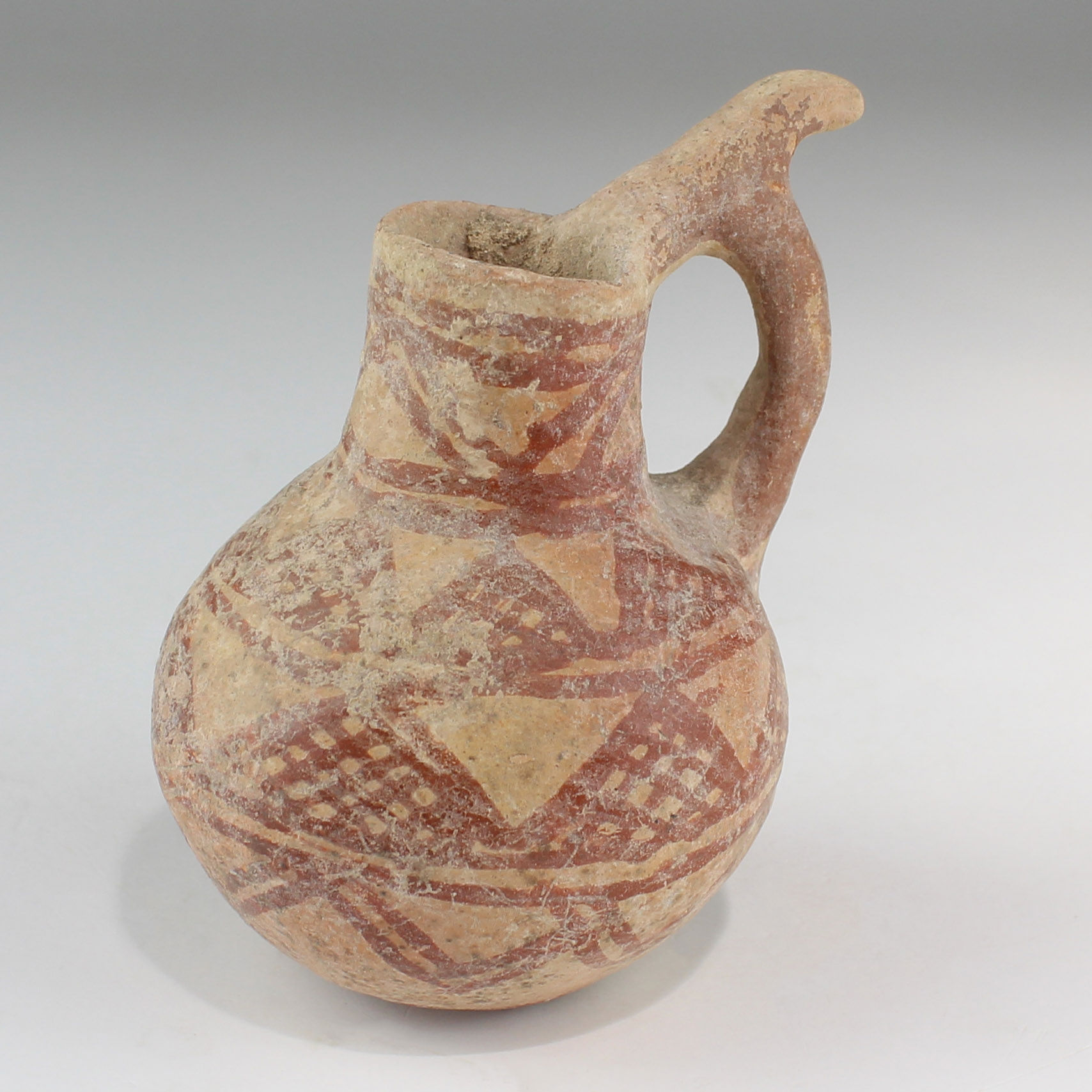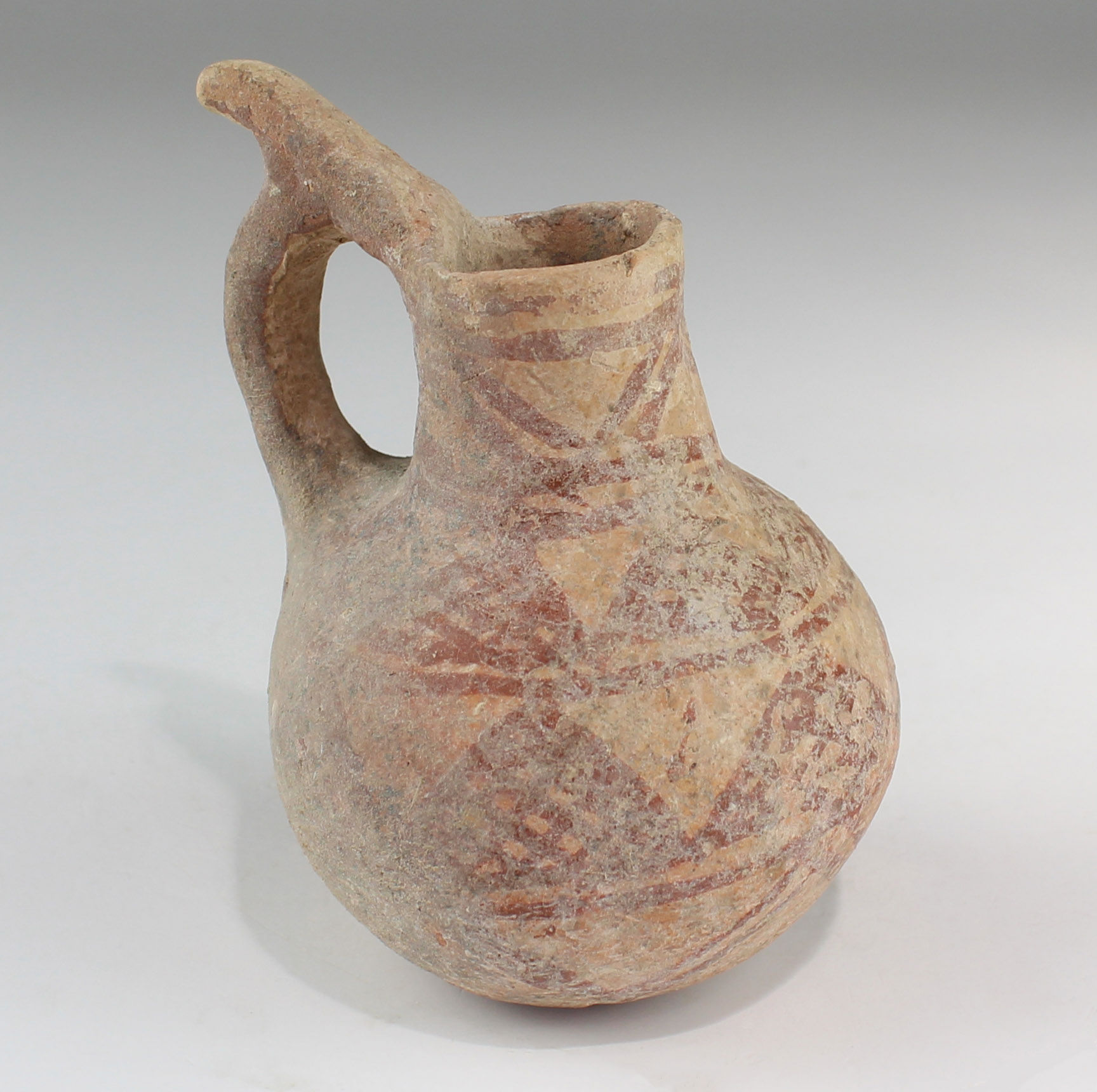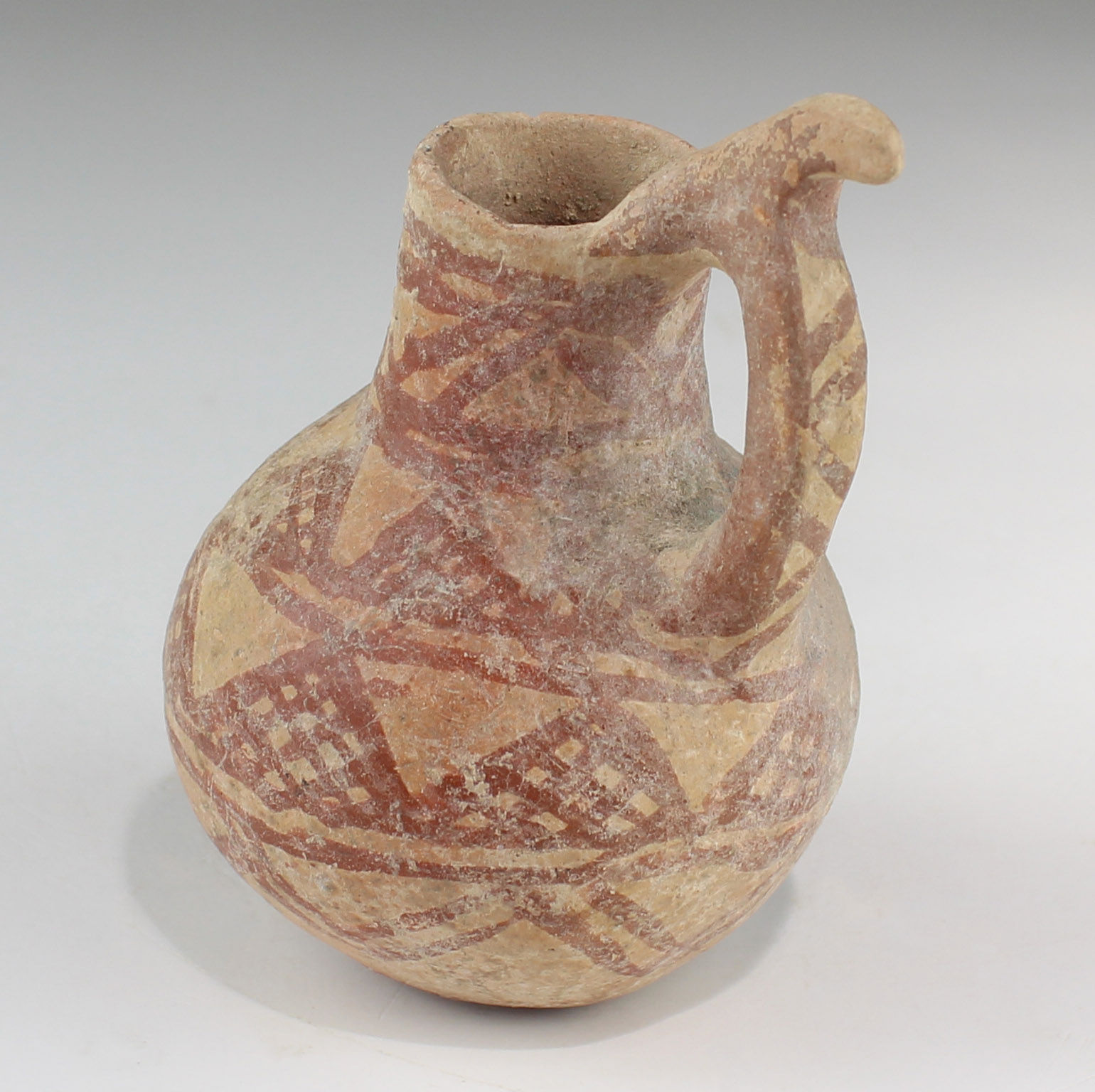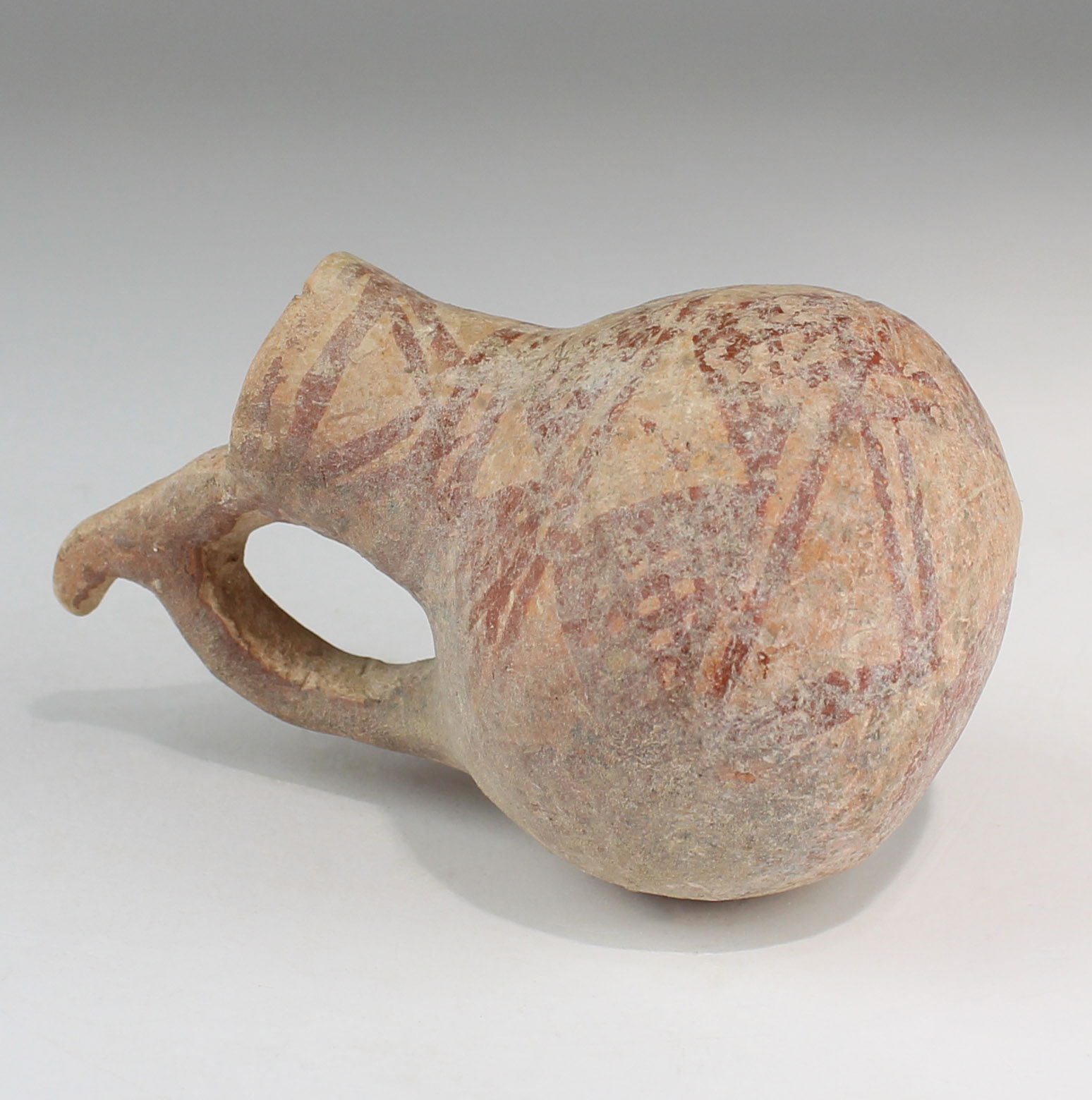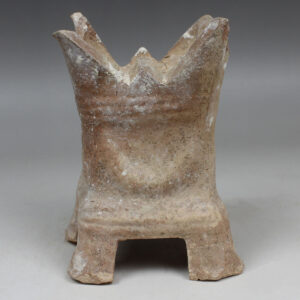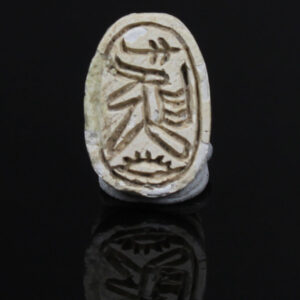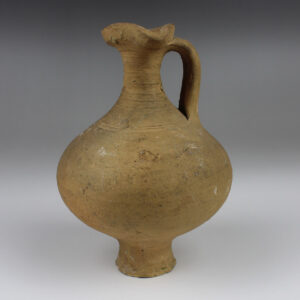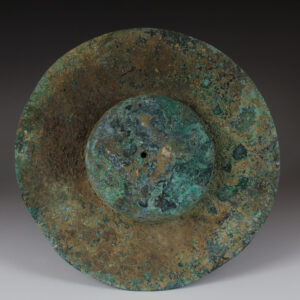Description
| ITEM | Miniature jug |
| MATERIAL | Pottery |
| CULTURE | Bronze Age, Cypriot |
| PERIOD | 1650 – 1450 B.C |
| DIMENSIONS | 78 mm x 65 mm |
| CONDITION | Good condition |
| LOCATION | Museum Exhibiton of the Arbeitsgruppe für Biblische Archäologie, Mainz (Germany) |
The Middle Bronze Age, which follows the Early Bronze Age (1900–1600 BC), is a relatively short period and its earlier part is marked by peaceful development. The Middle Bronze Age is known from several excavated settlements: Marki Alonia, Alambra Mouttes and Pyrgos Mavroraki. These give evidence of economy and architecture of the period. From Alambra and Marki in central Cyprus we know that the houses were rectangular with many rooms, with lanes allowing people to move freely in the community. At the end of the Middle Bronze Age, fortresses were built in various places, a clear indication of unrest, although the cause is uncertain. The most important cemeteries are at Bellapais, Lapithos, Kalavasos and Deneia. An extensive collection of Bronze Age pottery can be seen online from the cemeteries at Deneia.
The up to now oldest copper workshops have been excavated at Pyrgos-Mavroraki, 90 km southwest of Nicosia. Cyprus was known as Alashiya, the name is preserved in Egyptian, Hittite, Assyrian and Ugaritic documents. The first recorded name of a Cypriot king is Kushmeshusha, as appears on letters sent to Ugarit in the 13th century BC.
The beginning of the Late Bronze Age does not differ from the closing years of the previous period. Unrest, tension and anxiety mark all these years, probably because of some sort of engagement with the Hyksos, who ruled Egypt at this time but were expelled from there in the mid-1500s BC. Soon afterwards peaceful conditions prevailed in the Eastern Mediterranean that witnessed a flowering of trade relations and the growing of urban centres. Chief among them was Enkomi, near modern Famagusta, though several other harbour towns also sprang up along the southern coast of Cyprus. Around 1500 BC, Thutmose III claimed Cyprus and imposed a tax on the island.
Literacy was introduced to Cyprus with the Cypro-Minoan syllabary, a derivation from Cretan Linear A. It was first used in early phases of the late Bronze Age (LCIB, 14th century BC) and continued in use for c. 400 years into the LC IIIB, maybe up to the second half of the 11th century BC. It likely evolved into the Cypriot syllabary.
The Late Cypriot (LC) IIC (1300–1200 BC) was a time of local prosperity. Cities were rebuilt on a rectangular grid plan, like Enkomi, where the town gates now correspond to the grid axes and numerous grand buildings front the street system or newly founded. Great official buildings (constructed from ashlar-masonry) point to increased social hierarchisation and control. Some of these buildings contain facilities for processing and storing olive oil, like at Maroni-Vournes and “building X” at Kalavassos-Ayios Dhimitrios. Other ashlar-buildings are known from Palaeokastro. A Sanctuary with a horned altar constructed from ashlar-masonry has been found at Myrtou-Pigadhes, other temples have been located at Enkomi, Kition and Kouklia (Palaepaphos). Both the regular layout of the cities and the new masonry techniques find their closest parallels in Syria, especially in Ugarit (modern Ras Shamra).
Rectangular corbelled tombs point to close contacts with Syria and Palestine as well. The practice of writing spread, and tablets in the Cypro-Minoan script have been found on the mainland as well (Ras Shamra). Ugaritic texts from Ras Shamra and Enkomi mention “Ya”, the Assyrian name of Cyprus, that thus seems to have been in use already in the late Bronze Age.
Cyprus was, at some times, a part of the Hittite empire but was a client state and as such was not invaded but rather merely part of the empire by association and governed by the ruling kings of Ugarit. As such Cyprus was essentially “left alone with little intervention in Cypriot affairs”. However, during the reign of Tudhaliya IV the island was briefly invaded by the Hittites for either reasons of securing the copper resource or as a way of preventing piracy. Shortly afterwards the island had to be reconquered again by his son Suppiluliuma II, around 1200 BC. Some towns (Enkomi, Kition, Palaeokastro and Sinda) show traces of destruction at the end of LC IIC. Originally, two waves of destruction, c. 1230 BC by the Sea Peoples and 1190 BC by Aegean refugees, or 1190 and 1179 BC according to Paul Aström had been proposed. Some smaller settlements (Ayios Dhimitrios and Kokkinokremnos) were abandoned but do not show traces of destruction.
The years of peace that brought about such a flowering of culture and civilisation did not last. During these years Cyprus reached unprecedented heights in prosperity and it played a rather neutral role in the differences of her powerful neighbours.
Rich finds from this period testify to a vivid commerce with other countries. We have jewellery and other precious objects from the Aegean along with pottery that prove the close connections of the two areas, though finds coming from Near Eastern countries are also plentiful.
In the later phase of the late Bronze Age (LCIIIA, 1200–1100 BC) great amounts of “Mycenaean” IIIC:1b pottery were produced locally. New architectural features include Cyclopean walls, found on the Greek mainland as well and a certain type of rectangular stepped capitals, endemic on Cyprus. Chamber tombs are given up in favour of shaft graves. Cyprus was settled by Mycenaean Greeks by the end of the Bronze Age, beginning the Hellenization of the island. Large amounts of IIIC:1b pottery are found in Palestine during this period as well. There are finds that show close connections to Egypt as well. In Hala Sultan Tekke Egyptian pottery has been found, among them wine jugs bearing the cartouche of Seti I and fish bones of the Nile perch.
Another Greek wave of colonization is believed to have taken place in the following century (LCIIIB, 1100–1050), indicated, among other things, by a new type of graves (long dromoi) and Mycenean influences in pottery decoration.
Most authors claim that the Cypriot city kingdoms, first described in written sources in the 8th century BC were already founded in the 11th century BC. Other scholars see a slow process of increasing social complexity between the 12th and the 8th centuries, based on a network of chiefdoms. In the 8th century (geometric period) the number of settlements increases sharply and monumental tombs, like the ‘Royal’ tombs of Salamis appear for the first time. This could be a better indication for the appearance of the Cypriot kingdoms. This period shows the appearance of large urban centers.


